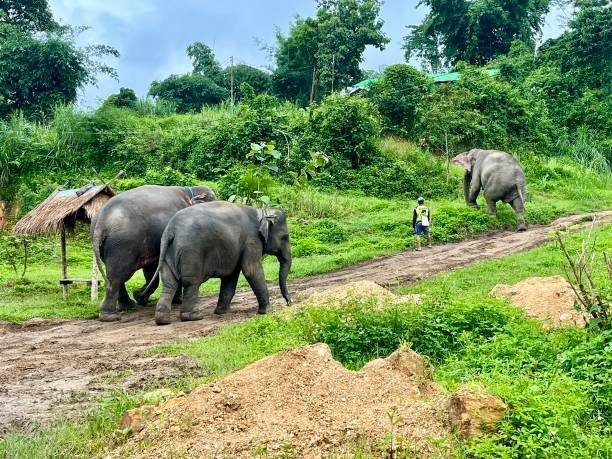How are injured elephants treated during rescue operations?

Introduction:
In this article, we delve into the crucial and compassionate world of rescuing injured elephants. The plight of these magnificent creatures often involves facing perilous situations, such as accidents, poaching attempts, or human-elephant conflicts, which leave them with serious injuries. During these trying times, dedicated teams of veterinarians, wildlife experts, and compassionate individuals come together to undertake the challenging task of treating injured elephants during rescue operations.
In this exploration, we will uncover the intricacies of the rescue process, including the initial assessment of injuries, the application of medical interventions, and the subsequent rehabilitation efforts. These operations are not only a testament to human empathy but also a lifeline for injured elephants, offering them a chance to heal, recover, and, ultimately, return to their natural habitat.
Initial assessment of elephants:
When rescuers arrive at the scene of an injured elephant, the first critical step is to conduct an initial assessment of the animal’s injuries. This assessment involves evaluating the extent and nature of the injuries, which may include wounds, fractures, or internal trauma. Observations are made to determine the elephant’s overall condition, level of distress, and mobility.
Rescuers, often working in close coordination with veterinarians and wildlife experts, use this initial assessment to form a preliminary treatment plan. They must prioritize actions based on the severity of the injuries and the elephant’s immediate needs. Additionally, they consider factors such as the elephant’s age, size, and temperament when planning the rescue operation and subsequent treatment.
Stabilization and emergency medical care on-site:
After assessing the injured elephant, the next crucial step is to provide immediate stabilization and emergency medical care on-site. This includes addressing life-threatening conditions and providing pain relief. In some cases, elephants may be immobilized to prevent further harm to themselves or the rescuers during treatment.
Veterinarians and wildlife experts often carry specialized equipment and medications to administer emergency care. They may clean and dress wounds, set fractures, or administer fluids and medications to stabilize the elephant’s condition. This on-site care aims to ensure that the elephant is stable enough for transportation to a specialized treatment facility, if required. It’s a race against time to provide the necessary care and prevent the injuries from worsening during the rescue operation.
Transportation to specialized:
Depending on the severity of the injuries and the availability of specialized treatment facilities, injured elephants may need to be transported for further care. Specialized elephant treatment facilities are equipped with advanced veterinary equipment and experienced staff who are trained in managing elephant injuries and ailments.
The transportation process is a complex and delicate operation, often involving the use of specially designed transport vehicles or crates. The elephant’s condition is closely monitored throughout the journey, and additional medical care may be administered en route. The goal is to minimize stress and discomfort during transportation while ensuring the injured elephant arrives at the treatment facility as quickly and safely as possible.
These specialized facilities offer a range of treatments, including surgeries, diagnostic imaging, and long-term rehabilitation programs, depending on the severity and type of injuries. They play a critical role in the recovery of injured elephants, providing them with the best possible chance of returning to their natural habitat or living a comfortable life in captivity if deemed necessary for their well-being.
Surgical interventions:
For severely injured elephants, surgical interventions and long-term medical treatment are often necessary components of their recovery process. After the initial stabilization and assessment, veterinarians may determine that surgical procedures are required to address fractures, internal injuries, or wounds that cannot be managed through conservative means.
Surgical interventions are performed under anesthesia, and specialized equipment is used to ensure the safety of both the elephant and the medical team. Depending on the complexity of the injuries, surgeries may range from simple wound repairs to more intricate procedures like orthopedic surgeries to mend fractures. These surgeries aim to alleviate pain, promote healing, and improve the elephant’s overall well-being.
Following surgery, elephants require long-term medical care, which may include wound management, antibiotic therapy, and pain management. The treatment plan is tailored to the specific injuries and the elephant’s response to the initial interventions. Regular veterinary check-ups and medical assessments are essential to monitor progress and make any necessary adjustments to the treatment regimen.
Physical therapy for injured elephants:
Rehabilitation and physical therapy play a vital role in the recovery of injured elephants. Once their immediate injuries have been addressed, the focus shifts to helping them regain their mobility, strength, and overall health. Rehabilitation typically takes place in a controlled environment that allows for close monitoring and specialized care.
Physical therapy for injured elephants includes exercises and activities designed to improve muscle tone, joint mobility, and overall fitness. Elephants may undergo water therapy, where they swim or wade in specially designed pools to reduce stress on their joints while building strength. Additionally, elephants are encouraged to engage in natural behaviors like foraging and exploration, which help them regain physical and mental well-being.
The duration of rehabilitation varies depending on the extent of injuries, but it often spans several months or even years. Caregivers and veterinarians closely track progress, adjusting therapy as needed to support the elephant’s recovery. The ultimate goal of rehabilitation is to prepare the injured elephant for potential release back into the wild or to ensure they have the best possible quality of life in captivity.
Release or sanctuary placement after recovery:
Once injured elephants have undergone surgical interventions, received long-term medical treatment, and completed rehabilitation, the next step is determining their future placement. This decision hinges on various factors, including the extent of their injuries, their ability to thrive in the wild, and the availability of suitable habitat.
In cases where elephants are deemed fit for release and there is an appropriate natural habitat, they may be candidates for reintroduction into the wild. This process is highly complex and requires careful planning and monitoring to ensure the elephant’s successful adaptation to their natural environment.
For elephants that cannot be returned to the wild due to the severity of their injuries or the lack of suitable habitat, sanctuary placement becomes the preferred option. Elephant sanctuaries provide spacious, naturalistic enclosures where elephants can live out their lives in a setting that mimics their natural habitat. These sanctuaries often prioritize the emotional and social well-being of the elephants, allowing them to interact with other elephants and lead fulfilling lives in a protected environment.
In both cases, whether released or placed in a sanctuary, ongoing monitoring and support are crucial to ensure the long-term well-being of these rehabilitated elephants. Their journey from injury to recovery is a testament to the dedication of conservationists and veterinarians committed to preserving the lives of these remarkable animals.
Conclusion:
I hope this comprehensive exploration of how injured elephants are treated during rescue operations has shed light on the compassionate and multifaceted efforts involved in helping these majestic creatures recover from trauma and injury. From the initial assessments and critical on-site medical care to surgical interventions, long-term treatment, and rehabilitation, every step is a testament to human dedication and empathy for these remarkable animals.
The ultimate goal of these endeavors is to provide injured elephants with the best possible chance for recovery and a return to their natural habitat whenever feasible. For those unable to return to the wild, sanctuary placement offers a comfortable and enriching environment where they can live out their lives with dignity.
As we continue to learn more about elephant care and conservation, our commitment to their well-being remains steadfast. It is through these collective efforts that we not only heal individual elephants but also contribute to the preservation of their species and the protection of their habitats, ensuring a brighter future for these incredible creatures.









Post Comment